
Harris&Ewing National Press Club Building newssstand, Washington DC 1940

• Past day: U.S. reports 26,540 new cases of coronavirus and 2,384 new deaths.
– Yesterday it had 27,243 new cases and 1,555 new deaths.
– Total: 608,458 cases and 25,992 deaths.
• New York adds over 3,700 deaths, of people who were never tested but are now presumed to have died from corona. Similar ‘recounts’ occur in multiple countries
• Coronavirus update, Americas:
– USA: 26,540 new cases
– Brazil: 1,509 new cases
– Canada: 1,383 new cases
– Peru: 519 new cases
– Chile: 392 new cases
– Mexico: 385 new cases
– Colombia: 127 new cases
– Dom Rep: 119 new cases
– Panama: 102 new cases
– Ecuador: 74 new cases

• Cases 2,014,000 (+ 79,872 from yesterday’s 1,934,128)
• Deaths 127,592 (+ 7,155 from yesterday’s 120,437)

From Worldometer yesterday evening -before their day’s close-
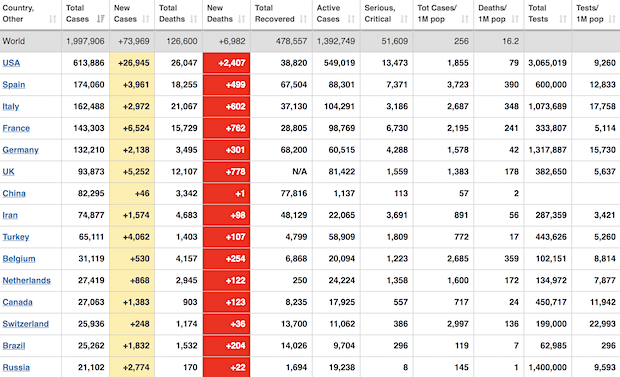
From Worldometer – NOTE: mortality rate for closed cases is at 21% !-
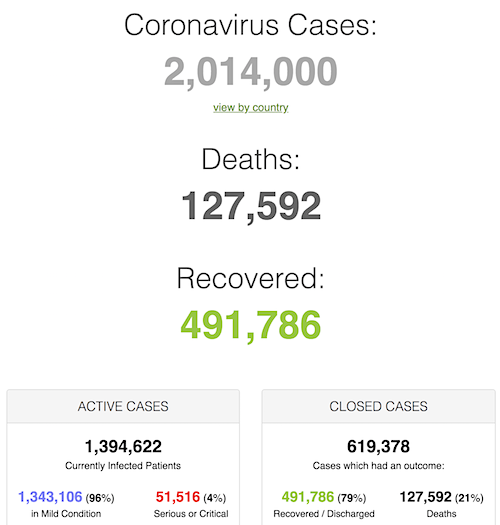
From SCMP:
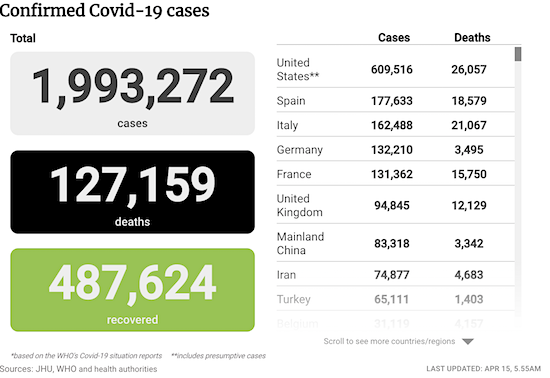
From COVID19Info.live: (Note: this indicates 6090 new US deaths, that can’t be true)
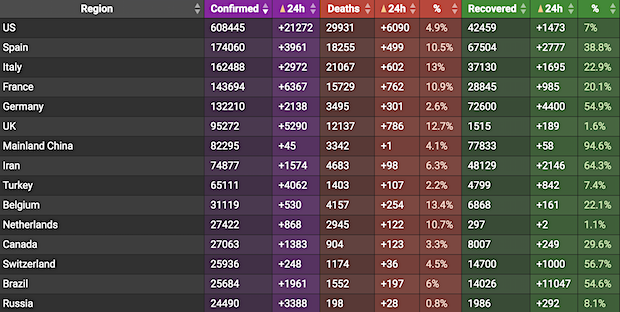

On Ben Hunt’s Epsilon Theory website, Rusty Guinn does an very extensive overview of who failed where: WHO, FDA, CDC, Universities, Media, Boards, Wall Street, Congress, Donald Trump.
There goes your afternoon.
• First, The People Die; Then, The Stories (Rusty Guinn)
The first World War was bloody and vicious. By its end, it had taken the lives of more than 20 million people. That number a few times over perished in the Spanish Flu that followed in its wake. It is a story that has been retold a lot lately. There were other casualties of the Great War, too. The narratives of a protective ruling class across Europe. Fervent embrace of trade and economic models based on colonialism and imperialism. Oligarchies and monarchies, yes, but belief in the capacity of oligarchies and monarchies to act benevolently and competently in the defense of the people, too. First, the people die; then, the stories.
The human toll of COVID-19 is unlikely to approach even a mean fraction of the pain visited on humanity in the first quarter of the 20th century. But what about the stories we tell about our global institutions, our shared values, and our own orthodoxies and authorities? Those stories are dying. They are dying because the institutions built on those stories failed us all, and all at once. First, the people die; then, the stories. The failures of these institutions were not simple mistakes, evidence of wrongness of one kind or another. The failures of these institutions were failures of narrative, devastating revelations of each institution’s fundamental inability to do what they said they would do. Revelations that their purpose was something other than the story they told about themselves.
In various ways they each held power over us through those stories, told using the language of our needs and values and beliefs. In a single event, the world proved those stories false on their faces. Whether we allow the world-as-it-is that was revealed by COVID-19 to change our commitment to these institutions and ideas is up to us; this is a time in which the world may be reshaped. In the past month and for the first time in most of our lives, each of us looked around and knew that everyone else had seen the same thing. We saw the emperors of our world standing naked as the day they were born. If the ravages of war and disease are humanity’s birthright, so too is the opportunity that comes along ever so rarely to seize something different. Something better.
Read more …

I found it hard to find coverage of this that did not immediatedly and extensively point to Trump’s own failings. But whatever those may be, they say little to nothing about the WHO’s failings. Can’t we keep these issues separate anymore?
• Trump Announces ‘Halt’ In US Funding To WHO Amid Pandemic (USAT)
President Donald Trump said Tuesday his administration will “halt” U.S. funding to the World Health Organization as it conducts a review of the global organization’s handling of the coronavirus pandemic. “We have deep concerns about whether America’s generosity has been put to the best use possible,” the president said in a Rose Garden press conference. “The reality is that the WHO failed to adequately obtain, vet and share information in a timely and transparent fashion.” Trump has accused the organization of not moving quickly enough to sound the alarm over COVID-19 and of being too China friendly. He has attacked the agency for advising the U.S. against banning travel from China to other parts of the world amid the outbreak.
“And the World – WHO – World Health got it wrong,” the president told reporters at the White House last week. “I mean, they got it very wrong. In many ways, they were wrong. They also minimized the threat very strongly and – not good.” Trump has previously said he was considering cutting WHO funding, but on Tuesday he accused the organization of “severely mismanaging and covering up” the spread of the coronavirus after the initial outbreak in Wuhan,China. The U.S. paid $893 million to the WHO during its two-year budget window, according to the organization’s website. That money represents about 15% of the WHO’s budget. Established in 1948, the WHO is an autonomous organization that works with the United Nations and is considered part of the U.N. system.
During Tuesday’s briefing, the president asked whether it was appropriate to freeze WHO’s funding in the middle of a pandemic that has claimed more than 125,000 lives worldwide with over 2 million cases confirmed, according to Johns Hopkins University data. “This is an evaluation period, but in the meantime, we’re putting a hold on all funds going to World Health,” Trump said. Trump said the review would last between 60 and 90 days. He said the administration would “channel” the money into other areas to combat the coronavirus outbreak, but declined to provide any specifics.
Read more …

What have they said about this since December, or in the past 10 years, for that matter?
• WHO Urges China To Close ‘Dangerous’ Wet Market As Stalls In Wuhan Reopen (Ind.)
The World Health Organisation is urging countries across the world to close “dangerous” wet markets amid warnings about the risks posed by environments where humans are in close contact with animals. Wet markets in Wuhan, the city where the coronavirus outbreak first emerged, have begun to reopen following the lifting of lockdown restrictions. This move comes despite the virus being linked to the city’s Huanan Seafood Wholesale Market. But WHO, as well as other public health organisations and campaigners, have said the markets pose a “real danger” as pathogens can spread easily and quickly from animals to humans. Dr David Nabarro, a WHO special envoy on Covid-19 and special representative of the United Nations secretary general for food security and nutrition, said the world health body “pleads with governments and just about everybody” to be respectful of how viruses from the animal kingdom are rife.
Speaking on BBC Radio 4’s Today programme, Dr Nabarro said while WHO is not able to tell governments what to do, their advice is to close wet markets. He replied: “You know how WHO and other parts of the international system work – we don’t have the capacity to police the world. Instead, what we have to do is offer advice and guidance, and there’s very clear advice from the Food and Agriculture Organisation and WHO that said there are real dangers in these kinds of environments. “75 per cent of emerging infections come from the animal kingdom. It’s partly the markets, but it’s also other places where humans and animals are in close contact. Just make absolutely certain that you’re not creating opportunities for viral spread,” added Dr Nabarro.
Read more …

To add to the long list of what is still not known about the virus. Epidemiology may not be very useful at this point.
• COVID19 Twice As Contagious As Previously Thought – Los Alamos Lab (SCMP)
The new coronavirus could have been twice as contagious as previously thought when it spread from its initial epicentre in central China, a fresh look at the early stages of the outbreak has suggested. Epidemiologists had previously estimated that each person with Covid-19, the disease caused by the virus, infected two to three people on average, based on early cases in the city of Wuhan. But researchers in the United States have said that the chaos in Wuhan as infections there rose at the start of the year may have produced incomplete data and a distorted picture. The new estimation by Los Alamos National Laboratory in New Mexico is that those who carried the coronavirus in Wuhan were passing it on to 5.7 people on average. The finding could help public health experts to refine their containment and vaccination strategies.
In their study, published last week in the journal Emerging Infectious Diseases, the researchers, led by Steven Sanche and Lin Yen-ting, wrote: “Unavailability of diagnostic reagents early in the outbreak, changes in surveillance intensity and case definitions, and overwhelmed health care systems confound estimates of the growth of the outbreak based on data.” The Los Alamos research analysed about 140 early patients outside Hubei province, of which Wuhan is the capital, to project how intensely the coronavirus was spreading from the epicentre. Most of the initial cases in other provinces had epidemiological links or exposure to Wuhan. “By the time cases were confirmed in provinces outside Hubei, all of the provinces of China had access to diagnostic kits and were engaging in active surveillance of travellers out of Wuhan,” the researchers said.
“The health care systems outside Hubei were not yet overwhelmed with cases and were actively searching for [their] first positive case, leading to much lower bias in the reporting.” Many provinces’ health commission or local Centre for Disease Control and Prevention (CDC) would also release basic epidemiological information on how each patient could have been related to another, or where they had shared exposure. The US researchers also used mobile phone data to estimate the numbers of daily travellers in and out of Wuhan. Their projection was then compared back with the death rate pattern in Wuhan, which was more clearly defined and consistent than the city’s other data on the outbreak. They found that instead of taking six to seven days for the number of infected people to double, as was previously thought, it took only 2.3 to 3.3 days to do so.
[..] In late January, researchers from mainland China and Hong Kong, including China CDC chief George Gao, had estimated that a Covid-19 patient could infect an average of 2.2 people, based on studying 425 patients in Wuhan. A more recent estimate of this reproduction number, by Imperial College London last month, found the figure for 11 European countries including Britain to be 3.87 people. Also last month, research at Payame Noor University in Tehran, which was subject to peer review, found that an average of 4.86 people could be infected per patient in the first week of the outbreak in Iran.
[..] The authors of the new Los Alamos study added that a higher level of infectiousness meant that if asymptomatic carriers accounted for a substantial proportion of transmission, then quarantine and tracing of contacts of those showing symptoms would not be enough to halt the virus’ spread. “When 20 per cent of transmission is driven by unidentified infected persons, high levels of social distancing efforts will be needed to contain the virus,” they said. “The decline in newly confirmed cases in [mainland] China and South Korea in March 2020 and the stably low incidences in Taiwan, Hong Kong and Singapore, strongly suggest that the spread of the virus can be contained with early and appropriate measures.”
Read more …

Reached a peak? I doubt it.
• New Coronavirus Outbreak Hotspots Emerging Across US (SCMP)
As infection rates begin to level out in New York and California finds success in flattening the curve, other states across the US are starting to reel as their coronavirus numbers spike in communities large and small. New York Governor Andrew Cuomo warned three weeks ago that his state was “the canary in the coal mine” presaging outbreaks around the country, and some now fear the worst is only starting to come. According to The New York Times, while half of the 10 US counties with the highest amount of coronavirus infections per residents remain in New York, the second highest per capita infection rate is in Blaine County, Idaho, in the intermountain West.
Home to fewer than 22,000 people, the county is best known for the Sun Valley ski resort, which draw a steady stream of skiers, outdoor recreation enthusiasts and owners of second homes from across the country – and is now making headlines for a coronavirus infection rate that is one of the highest in the world. In fact, as of Tuesday one of the largest single coronavirus clusters in the country was in the sparsely populated Great Plains state of South Dakota, where more than 300 workers at a giant pork-processing plant in Sioux Falls became sick with the virus over the weekend. While the total number of cases can seem more alarming in larger cities, for smaller towns the virus can be especially devastating both to their already overtaxed health care systems and fragile local economies.
Many smaller towns are kept afloat by only a few major employers, and when they close the effects can be catastrophic. In the south, Louisiana has been especially hard-hit, with Orleans Parish, home to New Orleans, battling the eighth largest degree of infection in the nation. Three relatively rural counties in Georgia make up the rest of the top 10 counties list — a clear reminder that not only large urban areas are at risk. While there is evidence that the rate of new cases and deaths is flattening out in Louisiana, the reality on the ground remains daunting. On Tuesday, the state health department reported 884 deaths and 21,016 positive cases across the state, with the virus now present in every one of Louisiana’s 64 parishes.
New Orleans alone has had 5,718 cases, and 244 deaths — with the contagion thought to have initially spread during the city’s Mardi Gras celebration in late February. Georgia, too, is reeling, with 14,223 confirmed cases of coronavirus and 501 deaths, with most of the deaths, 71, coming from Dougherty County, which has fewer than 100,000 people.
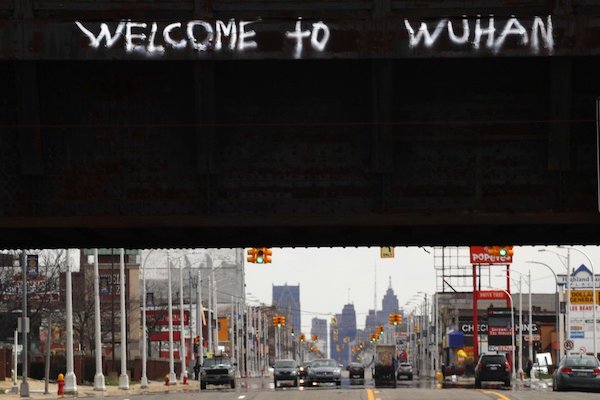
‘Welcome to Wuhan’ is spray-painted on a bridge in Highland Park, Michigan. Photo- AP
Read more …

Infected pregnant women is a scary idea. “Maybe third trimester immunosuppression has a role to play.”
• Universal Screening for COVID19 in NY Women Admitted for Delivery (NEJM)
Between March 22 and April 4, 2020, a total of 215 pregnant women delivered infants at the New York–Presbyterian Allen Hospital and Columbia University Irving Medical Center . All the women were screened on admission for symptoms of Covid-19. Four women (1.9%) had fever or other symptoms of Covid-19 on admission, and all 4 women tested positive for SARS-CoV-2. Of the 211 women without symptoms, all were afebrile on admission. Nasopharyngeal swabs were obtained from 210 of the 211 women (99.5%) who did not have symptoms of Covid-19; of these women, 29 (13.7%) were positive for SARS-CoV-2. Thus, 29 of the 33 patients who were positive for SARS-CoV-2 at admission (87.9%) had no symptoms of Covid-19 at presentation.
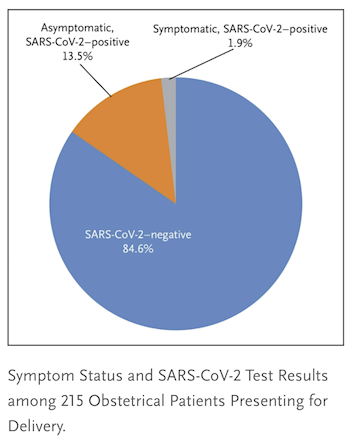
Of the 29 women who had been asymptomatic but who were positive for SARS-CoV-2 on admission, fever developed in 3 (10%) before postpartum discharge (median length of stay, 2 days). Two of these patients received antibiotics for presumed endomyometritis (although 1 patient did not have localizing symptoms), and 1 patient was presumed to be febrile due to Covid-19 and received supportive care. One patient with a swab that was negative for SARS-CoV-2 on admission became symptomatic postpartum; repeat SARS-CoV-2 testing 3 days after the initial test was positive.
Our use of universal SARS-CoV-2 testing in all pregnant patients presenting for delivery revealed that at this point in the pandemic in New York City, most of the patients who were positive for SARS-CoV-2 at delivery were asymptomatic, and more than one of eight asymptomatic patients who were admitted to the labor and delivery unit were positive for SARS-CoV-2. Although this prevalence has limited generalizability to geographic regions with lower rates of infection, it underscores the risk of Covid-19 among asymptomatic obstetrical patients. Moreover, the true prevalence of infection may be underreported because of false negative results of tests to detect SARS-CoV-2.
Read more …

Commendable, but in reality this is what every government should do, and 20% is not so much.
• New Zealand PM, Ministers Take 20% Pay Cut For Six Months (R.)
New Zealand Prime Minister Jacinda Ardern, ministers in her government and public service chief executives will take a 20% pay cut for the next six months amid the economic impact of the coronavirus pandemic. New Zealand’s offices, schools and non-essential services have been closed for the last three weeks, and economic activity is at a standstill as the country undertakes one of the strictest lockdowns globally. The government has forecast joblessness to surge because of the global and domestic slowdown.
“This is where we can take action and that is why we have,” Ardern said in a news conference announcing the decision. “We acknowledge New Zealanders who are reliant on wage subsides, taking a pay cut, and losing their jobs as a result of the global pandemic,” she added. New Zealand on Wednesday recorded 20 new cases of COVID-19, the disease caused by the new coronavirus, bringing the total number of cases to 1,386. It has recorded nine deaths so far.
Read more …

Let summer begin!
• Chinese Study Suggests Airco Helps Spread Coronavirus (SCMP)
A study of 10 coronavirus cases from three families who dined at the same restaurant in southern China has suggested that air conditioning aided droplet transmission between them. “Strong airflow from the air conditioner could have propagated droplets” between three tables, according to the report of the research, based on the infections in the city of Guangzhou in late January. Droplet transmission alone could not explain the infections, it concluded. Restaurants should increase the space between tables and improve ventilation to reduce the risk of infection, according to the report of the research, led by Jianyun Lu of the Guangzhou Centre for Disease Control and Prevention.
The research is revealed in an early-release article for the July edition of Emerging Infectious Diseases, the open-access and peer-reviewed journal published by the Centres for Disease Control and Prevention of the United States. Family clusters of infections have helped the spread of a pandemic in which the world’s total cases are approaching 2 million and the death toll has passed 120,000. The first patient of the 10 cases studied in Guangzhou had on January 23 returned from Wuhan, where the coronavirus was first reported in December. The person had lunch with three family members the next day at a windowless restaurant with an air conditioner on each floor. Two other families sat at neighbouring tables, with about one metre between each and an overlap in dining time of about an hour, the report said.
The first patient had a fever and cough later that day and went to hospital. Within two weeks, four further members of their family, three members of the second family and two of the third family had become ill with Covid-19, the disease caused by the coronavirus. After detailed investigation, it was found that the only known source of exposure for the second and third families was the first patient in the restaurant. “From our examination of the potential routes of transmission, we concluded that the most likely cause of this outbreak was droplet transmission,” the report said. “We conclude that in this outbreak, droplet transmission was prompted by air-conditioned ventilation. The key factor for infection was the direction of the airflow.”
Read more …

The idiot who wrote the next article should be quarantined without any means of communication. Whenever you read about a cost-benefit analysis of the virus, stop reading. Luckily, this tweet has the right approach to this:
• The Next Stage Must Be To Let The Virus Spread (AFR)
Last week, the government released the modelling it uses to inform its pandemic response. It appeared reticent; in press conferences, the government was keen to stress its limitations, its use of overseas assumptions and so on, as if to say: “We are not relying on models to decide what to do”. It should not have been. Disease modelling is one of the best tools we have for shaping our pandemic response. The government’s modelling is sound. It aligned closely with ours (I would hope so); we predict 32,000 daily ICU admissions at the peak if we do nothing, the government predicts 35,000. It presents a coherent picture of why we are “flattening the curve” and strong justification for what is being done today.
Australia is containing COVID-19 for now but needs to move on to the next phase. That requires an understanding of the costs and benefits of different social distancing measures and how best to change them as the pandemic proceeds. Our modelling sheds light on both, pointing to faster rather than slower relaxation. I was struck by the announcement that governments are expanding ICU capacity three-fold to 7000 beds. It is worth exploring the implications. Assuming patients admitted to ICU need eight days of treatment, 25 per cent of patients admitted to ICU will die, and that the case fatality rate for COVID-19 with treatment is about 0.5 per cent, it looks like governments are preparing for a peak of around 44,000 new infections a day, much higher than the number today.
I am encouraged by this. It signals that governments are contemplating a managed increase in the spread of the disease. As I said in The Australian Financial Review last week, in the absence of a vaccine or a cure, the best policy involves a managed increase in spread so that some degree of herd immunity develops, seeking to protect those most at risk while it does. How might we achieve this? One policy that is unlikely to work is to try to prevent every death. Why not? Because to do so we would need to eliminate infections entirely. That can only be done with severe and prolonged social distancing at prodigious economic cost (2 per cent of GDP per month for at least 10 months, at least $400 billion).
Read more …

What it really means to be an essential worker.
• California Meat Factory Workers Strike For Right To Be Tested (CN)
Dozens of One World Beef employees lined up in front of Valley Urgent Care to get tested for coronavirus Monday. Many of them participated in a strike that led to their employer granting this test to even occur. The employees say they decided to strike after some began getting sick and sanitary precautions weren’t being taken. Karicia Aguilar’s husband works for the company and said that their main fear was that her husband would contract the virus and spread it to their family. “My husband told me about a young man, who was his neighbor at the lockers who right now is on a ventilator. And so that situation really scared them and they realized they had to do something. They thought we could be taking the virus to our home and our families could get sick,” she said.
Some employees say they were told by HR if they did test positive they would be able to keep their jobs however the time off they took would be discounted from vacation and sick days. “We’re scared for our families. Our families are quarantined in our homes and we’re here working. And we’re in and out of the house. The one thing I hope is we still have a job. We work hard and we care about our job but we’re also concerned about our health,” said one factory worker. The fear of waking up every morning for work and not knowing whether or not you will contract the virus is a reality for many essential workers.
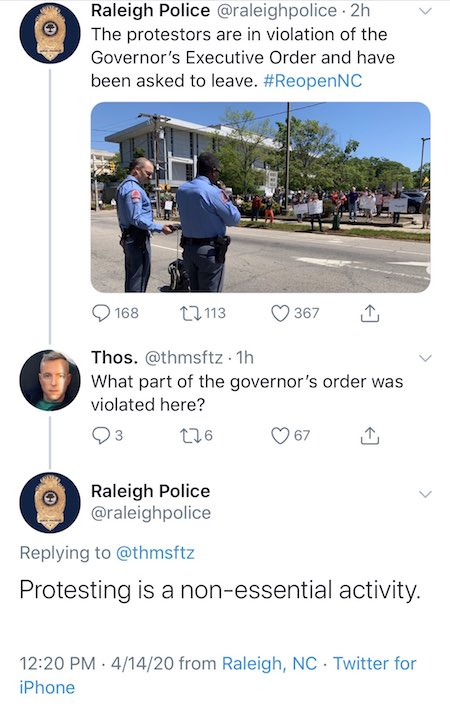
Read more …

A new world has arrived.
• California Governor Newsom Says Mass Gatherings Unlikely Through Summer (R.)
Mass gatherings of hundreds or thousands of people will likely be banned in California at least through summer, as the state plots reopening its economy and recovering from the coronavirus pandemic despite a spike in deaths, Governor Gavin Newsom said on Tuesday. Incremental steps to loosen stay-at-home orders could begin after “a few weeks” of evidence that the rates of infection and hospitalization from COVID-19, the respiratory disease caused by the novel coronavirus, are decreasing, Newsom told a news conference in the state capital, Sacramento. But he warned that socialization in the most-populous U.S. state would look very different for a long time even after the rules are eased.
“You may have dinner where the waiter is wearing gloves and maybe a face mask, where menus may be disposable, where your temperature is checked as you walk into the restaurant.” School start times may be staggered so children are not crowded together, and lunch and physical education periods may also change. Restaurants will likely have fewer tables – and forget about big celebrations for Memorial Day and the Fourth of July. “The prospect of mass gatherings,” Newsom said, “is negligible at best.”
Read more …

Massive testing campaign equals 1% of people?!
• South Korea Holds Parliamentary Election Under Strict Safety Measures (R.)
South Koreans began going to the polls on Wednesday to elect members of parliament under strict safety guidance in one of the first national elections held amid the coronavirus pandemic. About 14,000 polling stations were open at 6 a.m. (0900 GMT) around the country after disinfection, and voters were required to wear a mask and have a temperature check upon arrival. Anyone whose temperature was higher than 37.5 Celsius (99.5 Fahrenheit) was led to a special booth. All voters must use hand sanitizer and plastic gloves when casting ballots and maintain 1 meter (40 inches) distance between each other.
The election is set to decide control of parliament and shape President Moon Jae-in’s ability to push through his agenda in the final two years of his administration, including looser fiscal policy aimed at creating jobs, raising the minimum wage, and continued re-engagement with North Korea. Globally, South Korea was one of the first countries to hold a national election since the coronavirus epidemic began, while many others postponed votes. Once grappling with the first large outbreak outside China, South Korea has largely managed to bring its cases under control without major disruptions thanks to a massive testing campaign and intensive contact tracing. The Korea Centers for Disease Control and Prevention reported 27 new coronavirus cases on Tuesday, bringing the total infections to 10,564. The daily tally has hovered around 30 over the past week, most of them from overseas travelers.
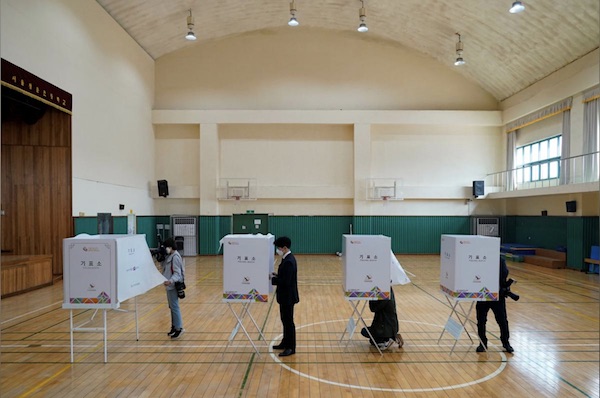
Media members cover inside a polling station for upcoming parliamentary election in Seoul, South Korea, April 14, 2020. REUTERS/Kim Hong-Ji
Read more …

I’m stunned. Stunned, I tell you.
“Just 2% of the businesses questioned said they had successfully accessed the government’s loan scheme..”
• UK Government Loans Not Reaching Businesses (Sky)
Around one in three British businesses have furloughed at least 75% of their workforce due to the coronavirus crisis, according to a new survey. The British Chamber of Commerce (BCC) found that two-thirds of businesses it spoke to said they had to put some staff on the furlough scheme, which covers 80% of salaries up to £2,500 a month. But just 2% of the businesses questioned said they had successfully accessed the government’s Coronavirus Business Interruption Loan Scheme, and the BCC said many need cash, quickly. It comes after the chancellor’s announcement in the Downing Street briefing on Tuesday that we are in “tough times” economically and that he “can’t protect every business and every household” throughout the pandemic.
Speaking to Sky News, the BCC’s Co-Executive Director Hannah Essex said: “If businesses don’t have the money in their accounts they’re going to have to look at all of their costs and make some really difficult decisions. “One of those will be if they continue to employ people even if they have the furlough scheme or not. “It’s so important to get the money into firms accounts so that they can take the time to make the best decisions for them, looking at what the future holds and what decisions come out this week about the lockdown, whether it continues or not.” She added: “This will be a hugely worrying time for businesses in Britain and especially for the people they employ. The economy has had an extraordinary impact across the country.
Read more …

The chairman of the Joint Chiefs of Staff shoots from the hip and largely misses.
• US Military Says Coronavirus Likely Occurred Naturally But Not Certain (R.)
U.S. intelligence indicates that the coronavirus likely occurred naturally, as opposed to being created in a laboratory in China, but there is no certainty either way, the top U.S. general said on Tuesday. The remarks by Army General Mark Milley, the chairman of the Joint Chiefs of Staff, could fan speculation about the coronavirus’ origins — something China has dismissed as a conspiracy theory that is unhelpful to the fight against the pandemic. Asked whether he had any evidence that the virus began in a Chinese laboratory and was perhaps released accidentally, Milley was non-committal at a Pentagon news briefing.
“There’s a lot of rumor and speculation in a wide variety of media, the blog sites, etc. It should be no surprise to you that we’ve taken a keen interest in that and we’ve had a lot of intelligence take a hard look at that,” Milley said. “And I would just say, at this point, it’s inconclusive although the weight of evidence seems to indicate natural. But we don’t know for certain.” Milley’s comments could again stoke tension with Beijing, where Chinese Foreign Ministry spokesman Zhao Lijian wrote on Twitter last month that the U.S. Army might have “brought the epidemic to Wuhan.”
Read more …

“Iraqi President Barham Salih said it was a “regrettable decision” taken by a commission which is independent of the government…”
• Iraq Suspends Reuters For Three Months Over Report On Coronavirus Cases (R.)
Iraq has suspended the licence of the Reuters news agency after it published a story saying the number of confirmed COVID-19 cases in the country was higher than officially reported. Iraq’s media regulator said it was revoking Reuters’ licence for three months and fining it 25 million dinars ($21,000) for what it said was the agency’s violation of the rules of media broadcasting. In a letter to Reuters, the Communications and Media Commission (CMC) said it had taken the action “because this matter is taking place during current circumstances which have serious repercussions on societal health and safety.”
Reuters said it regretted the Iraqi authorities’ decision and that it stood by the story, which it said was based on multiple, well-placed medical and political sources, and fully represented the position of the Iraqi health ministry. “We are seeking to resolve the matter and are working to ensure we continue to deliver trusted news about Iraq,” the news agency said in a statement. Asked about the Reuters suspension in an interview with Christiane Amanpour on CNN, Iraqi President Barham Salih said it was a “regrettable decision” taken by a commission which is independent of the government. “From my vantage point you would not get me in a situation where I would defend that. I’m working with our legal team in order to revoke that and manage the situation,” Salih said.
Read more …

“There was no secret agreement,” he told reporters at a regular news conference. “Nothing.”
• Trump Oil Deal Raises Question For Mexico: At What Cost? (R.)
Mexico’s president has incurred a debt with his U.S. counterpart Donald Trump by accepting U.S. help to end a standoff over global oil cuts, triggering concern the American will in return make the country pay on issues like migration and security. President Andres Manuel Lopez Obrador, a leftist oil nationalist, had balked at a demand by the OPEC+ group of oil producing nations to cut output by 400,000 barrels per day. Instead, he offered a cut of 100,000 bpd and said Trump “generously” agreed last week to help Mexico make up the rest. Trump has angered Mexicans by insisting the country will pay for a border wall he is building to keep out illegal immigrants. He has imposed a series of migration and trade-related demands on Lopez Obrador, and said Mexico would “reimburse” the United States for the oil cuts.
He has not yet said how. It could easily mean more demands on immigration and security, Sergio Alcocer, a former Mexican deputy foreign minister for North America, told Reuters. “This could become a joker, a sort of blank check,” for Trump, Alcocer said. Under U.S. coercion, Mexico has had to spend extra money on border policing, looking after asylum seekers and security. The thought of Trump having additional leverage has sown disquiet among both supporters and adversaries of Lopez Obrador. Lopez Obrador said on Tuesday he had not agreed to anything in return for Trump’s help on the oil cuts. “There was no secret agreement,” he told reporters at a regular news conference. “Nothing.”
Read more …

But! The Russians!
• GOP Senator Aims To Release Hunter Biden Investigation Report This Summer (NYP)
Senate Homeland Security Chairman Ron Johnson says he is aiming to release a status report on his investigation into Hunter Biden’s work for Ukrainian gas company Burisma Holdings “sometime this summer,” saying that the coronavirus pandemic “hampered” the probe. “We’re in the process of writing different sections of the report that I’d like to make public sometime this summer,” Johnson (R-Wis.) told Politico in an interview Monday. “But obviously, [the coronavirus] has not been helpful and hampered our efforts,” he added. The Wisconsin Republican told the outlet that committee staffers have been going through documents provided by the State Department and National Archives.
The National Archives’ documents include information from the Obama administration. “I’ve got staff that have been devoted to that and they’re working on that stuff from home. We — and I — can walk and chew gum at the same time here. This is not taking up massive amounts of staff time,” he said. Staffers are quarantining at home as the Senate remains in recess until April 20, a deadline that appears to be in flux. During that time, the committee is unable to take multiple actions regarding the probe, including being able to subpoena Blue Star Strategies, a Democratic consultancy firm that was hired by Burisma Holdings.
[..] Senate Republicans argue that Joe Biden may have acted inappropriately as vice president when his son — who had no material experience for the job — was given a high-paying seat on the board of Burisma when the elder Biden was in charge of US policy toward Ukraine. Senate Democrats, however, have argued that the investigation could aid efforts by Russians to spread disinformation and act as a smear campaign for the Democratic presidential candidate, Joe Biden.
Read more …

We would like to run the Automatic Earth on people’s kind donations. Ads no longer pay for all you read, your support has become an integral part of the process.
Thanks everyone for your generous donations.





https://twitter.com/i/status/1249881789503623170

Support the Automatic Earth. It’s good for your mental health.





















